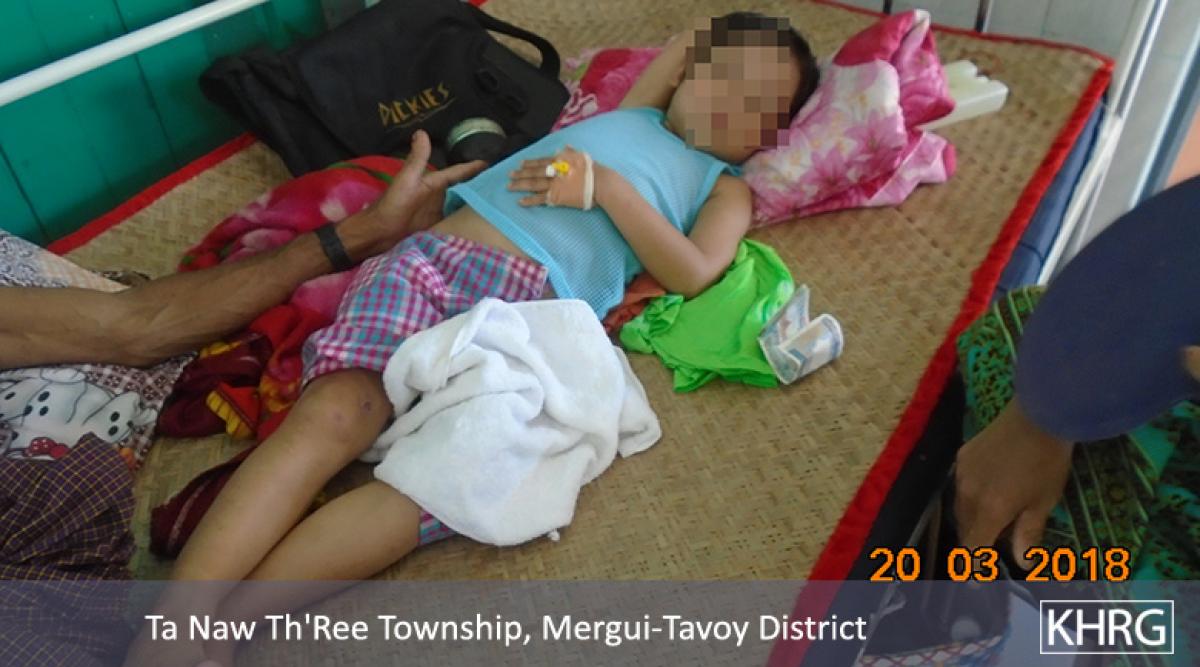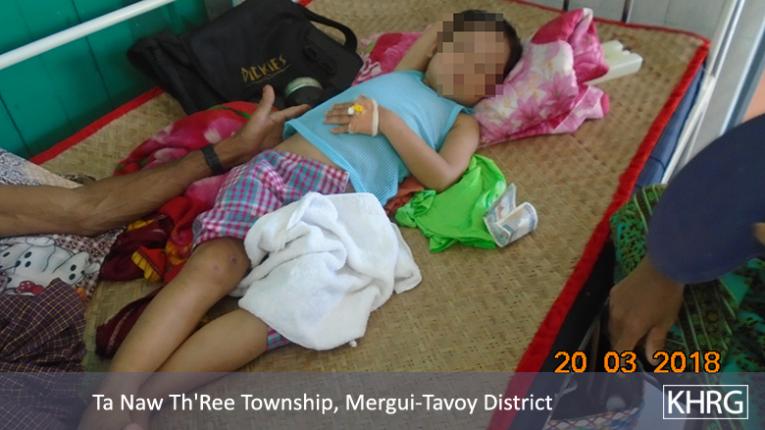This Interview with Naw N--- describes a case of child rape and incest that occurred in Tanintharyi Township, Mergui-Tavoy District in March 2018. A man raped his five-year-old niece in O---village. The girl sustained serious injuries and was hospitalised. The Burma/Myanmar police investigated the case and arrested the perpetrator. As of April 2018, no judgement has been rendered because the case is still in progress.
Interview | Naw N---, (female), O--- village, Tanintharyi Township, Mergui-Tavoy District (April 2018)
The following Interview was conducted by a community member trained by KHRG to monitor local human rights conditions. It was conducted in Mergui-Tavoy District on April 6th 2018 and is presented below translated exactly as it was received, save for minor edits for clarity and security.[1]This interview was received along with other information from Mergui-Tavoy District, including eight other interviews and 81 photographs.[2]
Ethnicity: Karen
Religion: Christian
Marital Status: Married
Occupation: Farming
Position: Villager
What is your name?
My name is Naw N---.
How old are you?
I am --- years old.
I have heard about a recent incident that occurred involving your grandchild. Could you please tell me the date when this incident occurred?
The incident occurred on March 18th 2018.
Do you know the exact time when the incident occurred?
I do not know [at what time it happened] because I was not at home at the time.
How did you learn about it?
When my granddaughter arrived home, I prepared a meal of rice for her. When she was eating the rice, she told me, “A’Moh [Mama], I want to have a poop”. Then I said, “You may go!” When she came back from the toilet, I saw that her pants were wet. Her brother said, “Naw E--- peed her pants”. Then, I pulled off her pants to clean them. Immediately, I saw that her [genitals] were torn and bleeding. At the time, I could not figure out what had happened to her, so I asked someone to inform the girl’s mother.
When you saw her injuries, what did you think happened to her? Did you think somebody hurt her at the time?
I did not know what had happened to her. I knew there was only one person who had recently been with the girl. Therefore, I thought that he [could have hurt her].
Who was recently with the girl?
That person is called Hpoh Aung.
Where did Hpoh Aung take the girl?
When I asked him, he said that he took my granddaughter to the mountain. However, I did not witness what he did to her, because I was not with them [at the time].
How did you find out that the girl had been raped?
I found out that she had been raped when I took her to the hospital. A nurse said that the girl had been raped. She asked who the perpetrator could be. I could not answer this question because I did not know who the perpetrator was yet.
However, I thought that [it could be] the man who had recently taken the girl to the mountain. Therefore, I reported the case to the police. Then, the police office administrator investigated the case. Finally, after I gave information to the police, they arrested the perpetrator.
Were the police officers able to arrest the perpetrator that same day?
No, the police officers arrested him the following morning when they went to the village. I did not know at what time the police arrested the perpetrator because I was at the hospital taking care of my granddaughter.
Who is the police administrator?
I do not know the name of the police administrator.
Where was the perpetrator arrested?
He was arrested in the house of a local villager, Theh Htaw [deacon] Hpoh Chee, in O--- village.
Is Theh Htaw Hpoh Chee a relative of the perpetrator?
No, they are not related. He did not even know about the incident.
How do you think the incident happened?
It was horrible. We could not do anything except share information with the police who are investigating the incident.
How is the perpetrator related to your family?
Hpoh Aung is the husband of my daughter [and the girl’s uncle]. He picked the girl up every day at school and took her home every day. The girl did not suspect anything because she always goes with him to and from school. So, when he asked her to go to the mountain, she followed him.
On the day the incident occurred, Hpoh Aung was drinking alcohol with the girl’s father [Maung C---] and a villager named Kyaw T---. The girl’s father fell asleep when he got drunk. [Once he had fallen asleep,] Hpoh Aung took the girl to the mountain when no other adults were around. The girl’s mother had gone to look after the cows grazing in her pasture. I was not at home either.
When the girl’s father woke up, he could not find his daughter. Then, the girl’s mother came back home and asked, “Where is our daughter?” He said, “She might have followed her uncle.”
When Hpoh Aung came back, the girl’s parents asked, “Where did you take our daughter?” He said, “I took her to the mountain.” However, we do not know how far he took the girl. During the investigation, police officers asked him to show them the place where he raped the girl.
So, have you seen the place where the girl was raped?
No, I was at the hospital when the police investigated the location where the incident took place. The police went there with the village elder, the perpetrator and some other villagers.
Had the perpetrator taken any drugs in addition to alcohol when the incident happened?
I only know that he was under the influence of alcohol. I do not know whether he took any drugs. I know that he drank alcohol in two different houses on that day.
Did the perpetrator have any plans to run away before he was arrested?
Yes, he planned to run away. He had already packed his luggage to run away to his village of origin. Fortunately, a villager saw the house where the perpetrator was hiding. When that villager was on the way back from his house, she met with a village elder who was looking for the perpetrator. She was able to tell the village elder that the perpetrator was in the house of villager Saw Theh Htaw Hpoh Chee. In this case, the village elder picked up two more village leaders named Htoo T’Aye and Lay Kler and arrested the perpetrator. Ultimately, the police also came to the village and arrested the perpetrator.
Did the police come along with village leaders to arrest the perpetrator?
Yes, the village leaders, Hpa Tee [uncle] Ngway Leh and Hsa Way, were there with police officers during the arrest.
How long did it take you to learn that the incident happened? Did it take a few days or weeks?
No, we found out about it the same evening the incident happened.
What time did you find out about the incident?
It was about 3 PM.
Are you satisfied now that the perpetrator was arrested?
Yes, I am satisfied.
How were the healthcare services at the hospital where you took the girl for treatment?
The healthcare services were fine. They provided financial support for the victim of about 20,000 kyats [$14.70 US].
Did the hospital provide any other support?
No. I also did not receive any information about the court case. I do not know when I will have to go to the police station again. The judge did not appoint the next court hearing the last time I attended court.
How many times have you attended court?
I went to the police station three times during the investigation and attended court once.
Did the judge inform you what the penalty would be for the perpetrator?
No, they have not decided on it yet.
What was the occupation of the perpetrator, your son-in-law?
He might have worked on a farm when he lived in his native village because most people in P’Wah village work on farms.
Does the perpetrator have any relatives here?
Yes, he has many relatives here but none of his siblings are here. His parents also live in this village.
Who are his parents?
Mugah [Aunt] Marry and Kyaw Shway Thaung. His mother is from here and his father is from P’Wah village, Tanintharyi Township.
Would you like to share more information about this?
The perpetrator’s parents did not stand with him but stood by the victim. On the day that the incident occurred, I called the perpetrator’s mother to go with me to the police office so that she would learn the truth about what her son did. However, his mother did not dare to go because she was ashamed of her son’s crime. Therefore, I went to the police office with my son, Saw Shee Moh and his wife. On the day that the incident occurred, I did not know what happened to the victim when I saw her injury. The perpetrator also told me that she might have fallen down and injured herself. At this point in time, we did not know the truth. Then, I took the victim to the hospital in order to know the truth. The girl also suffered because she would bleed whenever she would poop or pee. No one could take care of her injury in the village either. Ultimately, the truth appeared when I took her to the hospital. Then, I reported the case to the police immediately after finding out what happened to the victim. As a result, the perpetrator was arrested the day after I reported the case.
Footnotes:
[1] KHRG trains community members in southeastern Burma/Myanmar to document individual human rights abuses using a standardised reporting format; conduct interviews with other villagers; and write general updates on the situation in areas with which they are familiar. When conducting interviews, community members are trained to use loose question guidelines, but also to encourage interviewees to speak freely about recent events, raise issues that they consider to be important and share their opinions or perspectives on abuse and other local dynamics.
[2] In order to increase the transparency of KHRG methodology and more directly communicate the experiences and perspectives of villagers in southeastern Burma/Myanmar, KHRG aims to make all field information received available on the KHRG website once it has been processed and translated, subject only to security considerations. For additional reports categorised by Type, Issue, Location and Year, please see the Related Readings component following each report on KHRG’s website.




